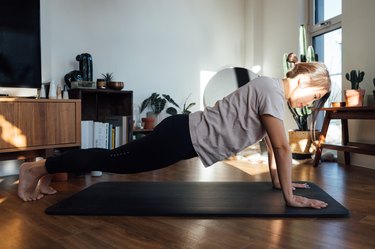
Working out can be a bit of a love-hate situation. You love the results, but the process isn't always fun. And some exercises can be downright awful — morale-crushing, seemingly ungratifying and all kinds of unpleasant for one reason or another.
Unsurprisingly, this usually includes exercises people don't do well. In other words, they're hard! But it brings to mind the saying, "If it doesn't challenge you, it doesn't change you." Here are some of the most dreaded exercises and how making peace with them can help you reach your goals faster.
Video of the Day
Video of the Day
1. Burpee

You know an exercise is tough when you find T-shirts about it. "Those burpees were fun — said no one ever" was clearly created by someone who was not a fan of this challenging exercise.
To do it, you first squat down, place your hands on the floor in front of you, jump back into plank, do a push-up, jump your feet back to your hands, then reach your arms overhead and jump. Only to repeat it all over again... and again and again.
"They're hard because you are using so many different muscles," says Pete McCall, master trainer and blogger for the American Council on Exercise. "Plus, it's an explosive exercise, and your body is not made to do a lot of them."
But they're an incredible full-body exercise, which is ideal when you're short on time, he says. Do no more than 15 reps in a set, though, McCall advises, so you don't end up lapsing into poor form or possibly injuring yourself.
Related Reading
2. Man Maker

Another combination exercise, the move dubbed the "man maker" (though anyone will have a rough time huffing through it) combines three tough exercises into one even tougher move.
With a pair of dumbbells (or kettlebells), you first perform a push-up, which is followed by a row on each arm. Then, you jump into a squat and immediately stand and lift the weights into an overhead press.
This one is definitely not for beginners. And it's little wonder why it's not such a popular exercise.
"You're using so many muscles in one movement that 5 sets of 8 of those will thrash you," McCall says. He also notes that many of these types of high-intensity exercises are often taken from Navy SEAL training and designed to weed out the weaker people.
"You shouldn't do them every day because you're working at a different level," he says. Do them on alternate days with lighter, less intense exercises to avoid injuring yourself.
3. Push-Up

When "Drop and give me 20!" is used as a punishment, how are you supposed to love push-ups? As with burpees, push-ups use a number of different muscles all at once, which increases the difficulty and decreases the fun factor. But it's also what makes them time-efficient and effective.
Push-ups are really a moving plank, so they require a lot of core strength, says Mark Nutting, CSCS*D, owner and master trainer at Jiva Fitness in Easton, Pennsylvania. Plus, they're great for the chest, front of the shoulders and triceps and don't require any equipment, he says.
If you're intimated by them, Nutting suggests starting with incline push-ups, leaning on a higher object like a countertop and gradually working your way lower until you can do them on the floor.
Related Reading
4. Mountain Climber

Another total-body exercise (seeing a pattern here yet?), mountain climbers get your heart racing, your legs pumping and your upper body firing on all cylinders — at the same time! They're a popular addition to HIIT and boot camp-style classes.
Mountain climbers challenge your balance, agility, proprioception (an aspect of balance) and coordination, says certified personal trainer, Teri Jory. "They fire up nearly every muscle group in the body, including deltoids, biceps, triceps, chest, obliques, abdominals, quadriceps, hamstrings and hip abductors."
Use time, not reps, as you build endurance. See how many you can do in 30 seconds and try to increase your reps or time each day.
Related Reading
5. Pull-Up

Good old-fashioned pull-ups are probably the most important exercise that most people — particularly women — avoid, says Wayne Caparas, author of Biological Revelation: The 10 Minute No-Sweat Anti-Aging Workout.
Pull-ups are critical to the development of the invaluable fast-twitch and super-fast-twitch muscle fibers (our fight-or-flight fibers) in the lats and their peripheral muscle groups, he says.
They're also a legit survival exercise if you need to pull or hold your own body weight. Caparas recommends starting with a spotter or using a resistance band or machine to support some of your weight and working up to 15 full-range, controlled pull-ups without assistance.
Related Reading
6. Box Jump

Explosive exercises (called plyometrics) range from easy (jumping jacks) to high-intensity moves. Box jumps fit into the latter and are dreaded by people everywhere. They build power and target the fast-twitch muscle fibers.
The challenge makes them enticing to try, but doing them incorrectly can land you in a world of hurt. But when done with proper form, box jumps increase the elasticity of the Achilles tendon and help prevent injuries to the tendon, which are quite common, McCall says.
The key to doing them correctly is to jump up and step down — don't jump back down, he says. "Trying to jump back down increases risk of injury." And be sure to thoroughly warm up. Then, perform some small jumps before attempting a full box jump.
7. Sprinting and Running

Running may be a quick way to burn calories, but it's also one of the toughest forms of cardio. To help yourself get acclimated to the idea of running, it may be helpful to go back in time a a few years.
"As kids, running was natural and part of our lives," Nutting says. "Like most physical activities, when we stop doing them, they become a challenge. Running and sprinting are like that. People who dislike running have probably not run in a long time."
Calorie burning is only one of the benefits. "Running is a great way to train your cardiovascular system," Nutting says. "It can be meditative, gets you outside in the fresh air and has a low equipment need (just a good pair of running shoes)."
Adding sprints to your running repertoire also builds power, which you need more as you get older, he says. "Sprints also increase your metabolic rate, so you burn fat even more than longer, slower running."
Related Reading